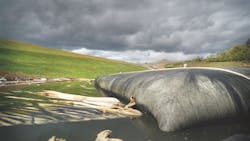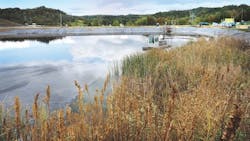About the author: Rick Marchant is director of corporate sales for the industrial water division of MPW Industrial Services. Marchant can be reached at [email protected] or 205.394.6539.
Ash ponds have been as much a part of the landscape at coal-fired power plants as stockpiles of coal and the conveyors that carry the fuel source to furnaces.
U.S. Environmental Protection Agency regulations that went into effect late last year, however, have power plant operators scrambling to close wet storage facilities, which receive roughly 30% of the approximately 100 million tons of coal combustion residuals generated each year.
Averaging 50 acres and 20 ft in depth, ponds are engineered structures for the storage of bottom ash and fly ash as well as boiler slag and flue gas desulfurization materials. Pond breaches impacting ground and surface water led to stricter regulations for the safe disposal of coal ash because pond leachate contains heavy metals including arsenic, cadmium, chromium, copper, iron, lead, nickel, silver and zinc.
There are approximately 700 active onsite surface impoundments in the U.S., and each pond requires a unique approach to management. That approach is largely determined by the chemical composition and concentration of contaminants in the pond and the plant’s permitted discharge limits.
The Big Three
The first challenge in any remediation plan is to address the total suspended solids (TSS) in the free water, which is typically decanted or pumped. Options include the use of clarifiers, media filtration and ultrafiltration.
Clarification. In general, mobile clarification will remove the highest levels of TSS, often greater than 1,000 ppm, and eliminate 85 to 90% of solids. Clarification offers onboard coagulation, which typically includes organic and inorganic polymers as well as acid or base addition. In some cases, metal precipitation will occur in the clarifier.
Clarification is labor intensive. It requires extensive monitoring and regular jar testing to confirm the effectiveness of the chemistry. Retention times for mobile, ballasted clarifiers equate to 1/10th of stationary clarifiers. In addition, the effluent treatment process is 90 to 95% efficient. Clarifiers do not perform well in situations that require frequent starts and stops, although those with microsand as ballast perform better under those conditions.
Media Filtration. The biggest advantage of conventional media filtration is the low power requirement. Most systems require no more than a 120-VDC extension cord.
Another advantage is the variety of media types that can be used to remove TSS specific to the free water in each pond. Media filtration units can also accommodate filter-aid addition.
Media filtration does not require chemical cleaning, but it does generate high volumes of backwash waste, which increases with the size of the filter. On average, media filtration will remove 80 to 90% of TSS, and the effluent treatment process is up to 95% efficient.
Media filtration does not provide a physical barrier to TSS, so particles smaller than 30 µ typically will pass through the system. Filter-aid addition can improve overall performance, however.
Ultrafiltration. The third option for removing TSS uses a semi-permeable membrane, which acts as a physical barrier. As a result, only particles 0.02 µ or smaller will pass through the system, essentially eliminating TSS-related fouling to downstream equipment.
Ultrafiltration generates a high-quality filtrate; however, ultrafiltration does require chemical cleaning and frequent backwash cycles. This process handles stops and starts better than other methods.
Dewatering
Regardless of the TSS method selected, the solid waste or sludge generated must be dewatered. Containers made from high-strength geotextile fibers, often referred to as geotubes, are a popular choice because they are relatively inexpensive and require little maintenance.
Geotubes require a significant amount of civil work to clear an area large enough to deploy them. Also, the sludge can take two to four weeks to dry. Heavy machinery is required to remove the dewatered solids.
Plate-and-frame presses require a small footprint and generate the driest solids, but they can be difficult to unload. Furthermore, removing solids from the site can be difficult, especially in temporary installations with limited space. Labor costs are typically higher than with geotubes, and most presses require the use of a thickener.
Belt presses, which often treat clarifier sludge, are easier to situate on site and offer consistent results. They operate well when solids constitute 2 to 10% of the effluent. Prescreening and grinders are sometimes required for belt presses.
TDS Removal
Once the suspended solids in the free and interstitial water have been removed, the focus turns to the dissolved solids in both streams. Reverse osmosis (RO) can be configured in both single and double pass, with the latter providing cleaner effluent. RO produces consistent effluent that often is below outfall effluent guidelines. If infrastructure allows, RO permeate can be reused in the plant makeup cycle or captured for other plant needs. When space is limited, a mobile trailer combining both ultrafiltration and RO can address TDS.
Metals Removal
Unlike TSS and TDS removals, which must be conducted in sequence, metals removal can be conducted at the beginning, middle or end or the treatment process. Some remediation professionals eliminate metals during the clarification stage with the use of iron salts, either reducing or co-precipitating the metals. Co-precipitation with iron salts at either high or low pH can eliminate selenium 4 (selenite), and eliminate selenium 6 (selenate) to a lesser degree. This approach typically generates significant amounts of sludge, which must be dewatered and removed from the site. Several technologies can reduce selenite and selenate to elemental selenium, including zero-valence iron (ZVI), activated alumina (AA) and biological treatment systems.
ZVI. ZVI donates electrons to selenite and selenate, reducing the heavy metals to elemental selenium. It requires large equipment footprints and high retention times. This tends to generate high sludge volumes and, at higher flow rates, contact time requires large quantities of specialty media, which can increase costs.
AA. Activated alumina is manufactured by thermal treatment of alumina. The thermal treatment process forms a micro-crystalline structure. The pore structure is accessible to solids with adsorption as the primary pathway for removing metal. Normally, AA can remove limited amounts of selenium and other associated heavy metals; however, as the selenium increases in water being treated, it may be necessary to consider other technologies, such as biological treatment systems, to achieve effluent discharge goals.
Biological treatment. Using this technology, cultured bacteria is added to a biological reactor filled with granulated carbon. Bacteria grows on the carbon substrate, generating a biofilm. The bacteria/biofilm reduces the selenium and other heavy metals under anaerobic conditions. Although many biological treatment units are stationary, systems developed in recent years are mobile and readily available for treatment at remote locations. Whether stationary or mobile, the effluent typically meets discharge guidelines while generating minimal wastes.
Onsite Effluent Monitoring
Meeting effluent guidelines is paramount to successful pond remediation. As a result, consideration should be given to locating a lab at the effluent end of the remediation process. This will ensure that the process is performing as intended regardless of variability in the influent.
Furthermore, this will assure plant officials, regulators and members of the community that water from dredged ponds that have been fixtures at power plants for generations has been discharged in a safe and responsible manner.

